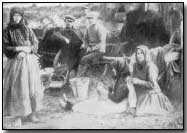Battles - The Battle of Gumbinnen, 1914
 Signalling the first major offensive on the
Eastern Front, and following an initial action by the German Eighth
Army at Stalluponen on 17 August 1914, the Battle of Gumbinnen was initiated
by Eighth Army's commander
General von Prittwitz, during the early hours of
20 August.
Signalling the first major offensive on the
Eastern Front, and following an initial action by the German Eighth
Army at Stalluponen on 17 August 1914, the Battle of Gumbinnen was initiated
by Eighth Army's commander
General von Prittwitz, during the early hours of
20 August.
Somewhat encouraged by the success of I Corps under the impatient, aggressive General Hermann von Francois in snapping up 3,000 Russian prisoners at Stalluponen, before pulling his corps back to Gumbinnen, 15 km to the west of Stalluponen (an attack launched by Francois without prior consultation with the Eighth Army commander), Prittwitz, encouraged by Francois, decided to press ahead with an assault against the Russian First Army under Rennenkampf at Gumbinnen.
Aware that General Samsonov's Russian Second Army was slowly winding its way northwards from the south, Prittwitz decided to engage Rennenkampf's forces, advancing across a 55 km front, at the first available opportunity. Eighth Army's strength was estimated at approximately 150,000, set against Rennenkampf's 200,000.
After assigning a corps to guard Eighth Army's rear, he dispatched three corps plus a further division to the line south of Gumbinnen, around 40 km inside the East Prussian border.
The German offensive was launched somewhat in haste, certainly before two of his corps were in readiness. General Mackensen - whose XVII Corps was sited in the centre - and General von Below - to the south - did not achieve a full state of readiness until some four to eight hours after Francois had commenced the attack in the north with I Corps at 4 am on the morning of 20 August. As for the additional division dispatched by Prittwitz, it arrived too late to see any action whatsoever.
Although Rennenkampf's forces defended with vigour, his right crumpled during mid-afternoon after running short of shells, with Francois forcing a Russian 8km retreat. This encouraged Mackensen to conduct an advance when his own forces were ready to attack at 8am, Below following at midday.
Alerted however by Francois's earlier attack, effective Russian deployment of heavy artillery wreaked havoc among Mackensen's troops, forcing him to withdraw some 24km, with Below, in disorder. Francois, aware that the German centre and right were in disarray, was similarly obliged to authorise a retreat; in the process the Russians managed to capture 6,000 prisoners during the German retreat.
Prittwitz, panicked by the effectiveness of the Russian counter-attack, and concerned that Samsonov's advancing southern Second Army would combine to envelop Eighth Army - despite Rennenkampf's apparent unwillingness to pursue his foe - ordered a general withdrawal to the River Vistula - effectively conceding the entire Russian invasion of East Prussia.
Helmuth von Moltke, the German Chief of Staff in Berlin, was furious at Prittwitz's capitulation. Promptly recalling Prittwitz and his deputy von Waldersee to Berlin - an effective dismissal - he brought the imperturbable Paul von Hindenburg out of retirement and gave him command of Eighth Army, assigning as his Chief of Staff the bold, aggressive Erich Ludendorff, who had latterly impressed during the German capture of Liege.
Fortunately for Hindenburg, the retreat to the Vistula had not been fully executed when he arrived in the east on 23 August. Consulting with Ludendorff and Colonel Hoffmann, Prittwitz's deputy chief of operations, he resolved to reverse Prittwitz's strategy of withdrawal, choosing instead to launch an offensive against Samsonov's approaching Second Army. This action resulted in possibly the greatest triumph of the war, at Tannenberg.
Click here to view a map charting the Battles of Stalluponen and Gumbinnen.
Photograph courtesy of Photos of the Great War website
A "dope can" was a metal syringe containing petrol for priming an aircraft engine.
- Did you know?
